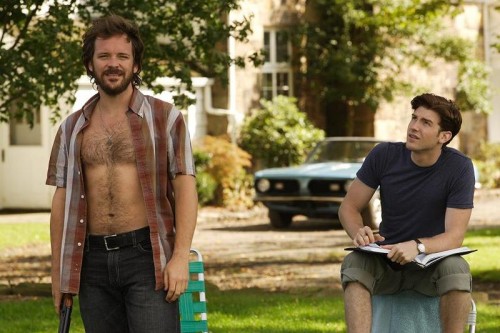The Mysteries of Pittsburgh
Dystopia of the Mind

Starring: Peter Sarsgaard, Sienna Miller
By Robert Patrick
Director Rawson Marshall Thurber, who previously helmed the comedic undertakings of Dodgeball: A True Underdog Story, plows his fists into a genre, so achingly different from his last endeavor, that the results are fettered by his own overzealousness. The Mysteries of Pittsburgh, originally penned by the much heralded Michael Chabon, gets doused with cold water, because of Thurber’s shrill handling of the story, making the film seem contrived and wholly unnecessary. Really, it’s the over ambition of Thurber that leaks into the story, eventually drowning the entire film, making it that difficult to wad through.
Art Bechstein, a recent college graduate, gets scooped up in the hands of some very unsavory acquaintances in Thurber’s homage to the evils of summertime. Art coils up his books, plants them in his backpack, and takes a job shelving novels at Bookbarn, where, according to the characters, there isn’t one copy of Bukowski to be found. Soon, Art’s life, stoic and static as it sounds, begins to plunge into an abyss of perversity and transient indiscretion. Between methodically blipping barcodes, Art has an elicit affair with his boss, Phlox (Mena Suvari), which, to his ultimate chagrin, provides him with the opportunity to writhe around his place of employment satisfying someone other than himself. Before too long, however, Art meets Jane Bellweather, a women with serpentine motives, who provokes interest from the young Bookbarn employee. The two, despite obvious warning signs from Jane’s questionable personality, engage in a night of conversation. Later, Jane’s boyfriend, Cleveland Arning (Peter Sarsgaard), springs up and makes friends with Art, convincing him that they should all be summertime buddies.
In Cleveland’s opening scenes, its obvious, most notably from his mangy hair and unkempt beard, that he is a faraway cry from Art’s glossy appearance and outward sheen. Cleveland’s personality is volatile and impulsive, and, for the sake of morbid curiosity, Art follows his new friend’s grizzled mop of hair, like a skewed beacon of light, until there is nothing but darkness. Cleveland’s girlfriend – and Art’s eventual love interest – is equally unstable. The movie essentially follows these three makeshift friends as they attend bars, throw down shot glasses with the sound of someone breaking at a pool table, and maliciously flirt with each other. After a short while the personalities of these three people become porous, and eventually seep into one another, making them one unscrupulous entity. This story seems like something novelist Bret Easton Ellis would write during a binge of drugs and promiscuity.
The music in the movie, composed by Theodore Shapiro, has the same airy jingle of a Thomas Newman score. I’m not sure the music, complete with the melancholy plunking of keys and the light chimes of percussion, is a nod to Newman so much as a unauthorized reworking of his material. Whenever I heard the score drift into the movie, I felt distracted and was unable to comprehend why Thurber felt it necessary to use such a blatant facsimile in his film.
Aside from the smearing of the score, the actual song selections, which boasts artists such as Iron and Wine, are amiably used throughout. The faint hum of Samuel Beam’s voice works well over the creak of his guitar.
The acting is pretty standard, as Sarsgaard behaves creepily, not unlike his other movies; he lowers his eyelids often, snickers defiantly, and sweats profusely. Nick Nolte makes an appearance in the film, albeit for a brief amount of time, as Art’s overprotective father. Nolte spends most of his time sitting, almost as if he were fastened to the table. He occasionally mumbles something unintelligible, wags his finger, then calms back down. My biggest problem with the film is Sienna Miller. Playing an edgy druggie, she bops around showing thigh, then careens over a table vomiting; isn’t she this way in every film? I kept thinking she was still playing Edie Sedgwick. This opus, luckily for her, requires very little; she only has to slum around wearing a bikini, bat her eyelashes with the repetition of machinegun fire, and wear lots of eye makeup.
The dialogue in this film simply exists to get to the end of the movie, which, because of its self-indulgent attitude, thinks it has a good one. These characters are unlikable, and use each other for emotional whipping posts. We understand that Cleveland has the pronounced attitude of a fatalist, that Jane is a wreck of a person, and that Art is malleable beyond normalcy – but we never really care about them. The Mysteries of Pittsburgh doesn’t work because the movie forces you to try and care, rather than letting it happen organically.
If you want to watch a band of people act like a living, breathing Chinese finger trap, this is your movie. For my dollar, I’ll wait for a film to have something thoughtful to say about relationship issues, instead of recommending one that plays dress up with them.
2/5
